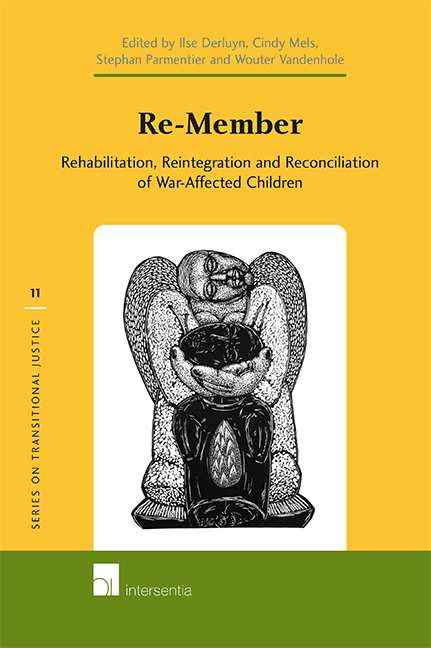Book contents
- Frontmatter
- Preface
- Foreword
- Contents
- Introduction: Children Affected by Armed Conflict at the Intersection of Three Fields of Study
- PART I SETTING THE SCENE: THREE DISCIPLINARY PERSPECTIVES
- PART II LESSONS LEARNT FROM CURRENT PRACTICES AND APPROACHES
- PART III EXPLORING RESOURCES THROUGH EMPIRICAL RESEARCH
- PART IV LOOKING BACK, REACHING FORWARD
- About the Editors
- About the Authors
3 - Integrating Transitional Justice and Disarmament, Demobilisation and Reintegration: The Need to Achieve Rehabilitation, Reintegration and Reconciliation for Child Soldiers and Child Victims of Enforced Disappearances
Published online by Cambridge University Press: 20 January 2021
- Frontmatter
- Preface
- Foreword
- Contents
- Introduction: Children Affected by Armed Conflict at the Intersection of Three Fields of Study
- PART I SETTING THE SCENE: THREE DISCIPLINARY PERSPECTIVES
- PART II LESSONS LEARNT FROM CURRENT PRACTICES AND APPROACHES
- PART III EXPLORING RESOURCES THROUGH EMPIRICAL RESEARCH
- PART IV LOOKING BACK, REACHING FORWARD
- About the Editors
- About the Authors
Summary
INTRODUCTION
An estimated 2 million children died as a result of armed conflict between 1994 and 2004. During this period about 6 million children were disabled or injured. Since the 1990s thousands of children have suffered the fate of enforced disappearance. At the same time there are an estimated 300,000 child soldiers in about 21 conflicts around the world. These numbers include forced, conscripted, and voluntary children from state as well as non-state actors. The problem is thought to be worst in Africa and Asia, but there are also instances in Europe and the Americas. In Colombia, for example, there are an estimated 14,000 children under thez age of ten involved in armed conflicts, in Uganda 20,000 children and an estimated 70,000 in Burma. Up to 200,000 children were left orphaned during the civil war in Mozambique. About 1 million Angolan children lost one parent in the war in that country and almost 300,000 lost both parents. Thus, the situation of children after war, and other types of conflict, is severe and in need of ongoing attention, especially as far as the needs of the child victim is concerned.
Besides the effect that conflict has on children, who are mostly merely bystanders, but dramatically affected, often as a result of the conflict, children are at times forced to commit human rights violations, including murder, amputations, rapes and other forms of sexual violence during hostilities.This is done intentionally to make the abducted child feel stigmatised and less likely to try to run away and return home. Stigmatising children may also be a problem after their return home, and thus steps ought to be taken to prevent this, and deal with it where it has occurred.
This chapter explores the needs of child victims. It explores specifically their needs for reintegration and rehabilitation linked to processes of reconciliation. It does not focus, however, on dealing with children or others as perpetrators of violence. Obviously, dealing with perpetrators, including those who are children, and finding ways of ending the use of child soldiers, reducing enforced disappearances and other violations against children or those that affect children, are vital.
- Type
- Chapter
- Information
- Re-MemberRehabilitation, Reintegration and Reconciliation of War-Affected Children, pp. 77 - 102Publisher: IntersentiaPrint publication year: 2012
- 1
- Cited by

